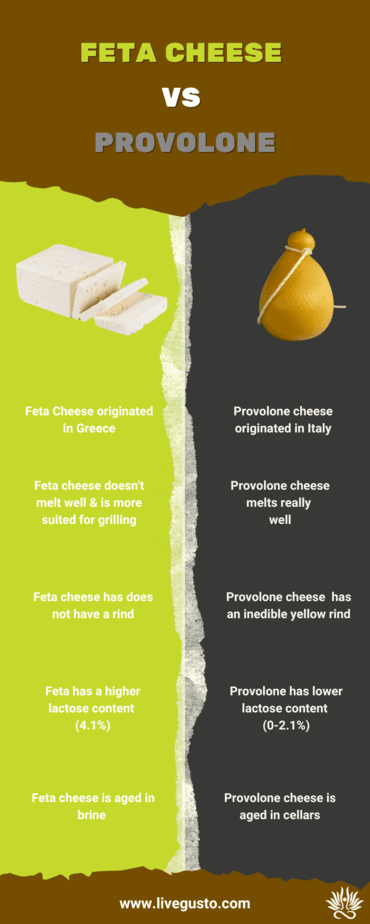Feta cheese vs provolone, ever wondered which one is the better option for you? Choosing between different types of cheese is hard, because most of them have very similar nutritional values.
This is why I am here to help you pick the best options. By comparing feta cheese vs provolone nutrition facts in detail, I will help you find the best one between the two.

PEOPLE ALSO READ
| Feta Vs Queso Fresco – Which one is a Better Choice? |
Feta Cheese Vs Provolone: Nutrition & Benefits Comparison
Let us take a look at feta cheese vs provolone benefits and nutrition, before we can delve deeper into each point-
| BASE INGREDIENT | |
| Feta Cheese
Sheep/ Goat Milk |
Provolone
Cow Milk |
| TYPE | |
| Feta Cheese
Soft |
Provolone
Semi-Hard |
| TASTE | |
| Feta Cheese
Tangy & Salty |
Provolone
Nutty & Buttery |
| AGED | |
| Feta Cheese
Yes |
Provolone
Yes |
| CALORIE CONTENT | |
| Feta Cheese
75* |
Provolone
100* |
| CARB CONTENT | |
| Feta Cheese
1.2 g* |
Provolone
0.6 g* |
| FAT CONTENT | |
| Feta Cheese
6 g* |
Provolone
8 g* |
| PROTEIN CONTENT | |
| Feta Cheese
4 g* |
Provolone
7 g* |
| CALCIUM CONTENT | |
| Feta Cheese
140 mg* |
Provolone
214 mg* |
| SODIUM CONTENT | |
| Feta Cheese
316 mg* |
Provolone
248 mg* |
| VITAMIN PROFILE | |
| Feta Cheese
Very Good |
Provolone
Very Good |
| ORAL & BONE HEALTH OUTCOME | |
| Feta Cheese
Very Good |
Provolone
Very Good |
| TUMMY HEALTH OUTCOME | |
| Feta Cheese
Very Good |
Provolone
Very Good |
| VERSATILITY | |
| Feta Cheese
Very Good |
Provolone
Very Good |
| SHELF LIFE | |
| Feta Cheese
Up to 2 Weeks |
Provolone
Up to 3 Weeks |
*Source: USDA; Quantity defined is 1 ounce (28.4g)
You will have more clarity, once we discuss these points further –
What Goes Into The Making of Feta Cheese Vs Provolone Cheese?
The true feta cheese is made using sheep milk or a mix of goat and sheep milk. The amount of goat milk, however, should not exceed 30%. The process begins by curdling of milk by addition of rennet and cheese culture. The curds obtained are then cut and are transferred into moulds. Once the whey is drained out, the blocks of feta are put into brine to age.
Provolone is usually made using cow milk using a method known as “pasta filata.” Milk is first curdled using cheese culture and rennet. The curds are then submerged into hot water or whey. They are then removed, stretched out and kneaded to obtain a stretchy and stringy texture. Further, the cheese is soaked in brine, then covered in wax and finally left to age in a cellar.
What Type of Cheese is Feta Cheese & Provolone?
Feta cheese is a type of soft cheese. A soft cheese is any type of cheese that is young and fresh and has a high moisture content.
Provolone is a semi-hard cheese. It has a lower moisture content and is more firm in its texture when compared to soft cheeses.
How Do The Taste & Texture of Feta and Provolone Cheese Differ?
Feta cheese is a white coloured soft and crumbly cheese. It has a mild, salty and tangy taste.
Provolone cheese is usually creamy yellow in colour. It is slightly springy and smooth in texture. The taste can vary with age anywhere from mild and sweet to butter and sharp.
How Does Aging Differ in Feta Vs Provolone Cheese?
Feta cheese is aged but in a different way. The aging is sone in brine and thus the cheese remains soft and rindless. The aging can take place anywhere between 2 to 12 months or more.
Provolone cheese is also aged but the aging is mostly done in cellars. On the basis of aging, provolone is divided into 2 categories –
- Dolce – Aged for two to three months
- Piccante – Aged for four months or more
Which One Has a Lower Calorie Concentration: Feta or Provolone?
Cheese is a high calorie food. This is because, they have a higher concentration of nutrients including fats and proteins.
If we compre the calorie content of feta and provolone cheese, we see that provolone has a higher calorie content.
Better Suited To Low-Carb Diets: Feta or Provolone Cheese?
Feta and provolone cheese are both low in carbohydrates. Carbohydrates are basically sugar molecules that are present in milk.
Feta comparatively has a higher carbohydrate content when compared to provolone cheese.
How Much Does The Fat Content Vary in Feta and Provolone Cheese?
Provolone cheese has a higher fat content when compared to feta cheese.
The nature of fats in feta and provolone cheese is, however, very similar to each other.
Which Has More Proteins – Feta Cheese or Provolone Cheese?
Feta cheese and provolone, both being dairy products are pretty high in protein content. Not only is the quantity good but so is the quality.
When compared to feta, provolone cheese packs a pretty high protein content. It is thus a good option for people wanting to include more protein in your diet.
Cheese That Boasts a Higher Calcium Content: Feta or Provolone?
Another essential nutrient that all dairy products are rich in is calcium. Calcium is a mineral which is primarily need to maintain strength of bones and teeth.
As compared to provolone, feta has a lower calcium concentration. Both types of cheese can be a good way of increasing your calcium intake.
Which Has Lower Sodium Levels: Feta or Provolone?
Feta and provolone are rich in nutrients, but one of their major disadvantages is the amount of sodium they contain. Therefore, people trying to limit their sodium intake should try to limit the consumption of both feta and provolone.
While feta and provolone are both loaded with sodium, the proportion of sodium in feta is much higher. So, watch out for your sodium intake.
Which Has a Better Nutrient Profile: Feta Cheese or Provolone Cheese?
Feta and provolone cheese both have excellent nutrient profiles. They are rich in many essential vitamins and minerals. Feta is an excellent source of B vitamins, vitamin K, calcium and phosphorus.
Provolone, on the other hand has a higher Vitamin A, Vitamin E, zinc, magnesium and potassium.
Feta or Provolone: Cheese Better For Bone & Teeth Health?
Feta and provolone are both rich in many bone friendly nutrients. They contain calcium, phosphorus, vitamin D, Vitamin K, protein, etc. Calcium and phosphorus are not only good for bone health but also aid overall dental health.
Provolone and feta additionally contain probiotics or good bacteria that help to keep bad bacteria in your mouth at bay.
Which Cheese is Easier on the Tummy: Feta or Provolone?
Feta and provolone both are a good source of probiotics. Probiotics or good bacteria that aid digestion and keep your gut trouble free.
Provolone cheese has an additional advantage as it contains very little lactose when compared to Feta. Lactose intolerance is very prevalent and many people face issues digesting lactose, a sugar present in milk. In such cases, provolone might be a better choice.
Feta or Provolone: Cheese With More Uses?
Feta cheese is used in a number of ways because of its mild flavour. It is not only used in Greek salad but also in a number of other dishes including sandwiches, ommellets and salads. Also, since it does not melt on heating, you can also grill it.
Provolone like feta finds its uses across cuisines and flavours. It is used as a table cheese served with fruits, vegetables and herbs. Since it melts well, you can also use it in pizzas, casseroles, pastas and sandwiches.
Storage technique & Shelf Life: Feta Vs Provolone?
Feta cheese can dry out very quickly and thus needs to be stored properly. Place it in brine or lightly salted milk so that it retains its taste and texture. Store bought feta can be kept in the refrigerator for up to 2 weeks when stored properly.
Provolone cheese can last two to three weeks in the refrigerator when stored properly. You need to wrap it in parchment paper followed by a plastic wrap or aluminum foil.
Feta and provolone are thus very nutritious options. Choosing between the two would depend on your tastes and preferences. If you want the cheese to melt, choose provolone, but if grilling is your need, feta is the way to go.
I hope you have better clarity about feta and provolone cheese. In case you have more questions, feel free to ask me in the comment section below.

